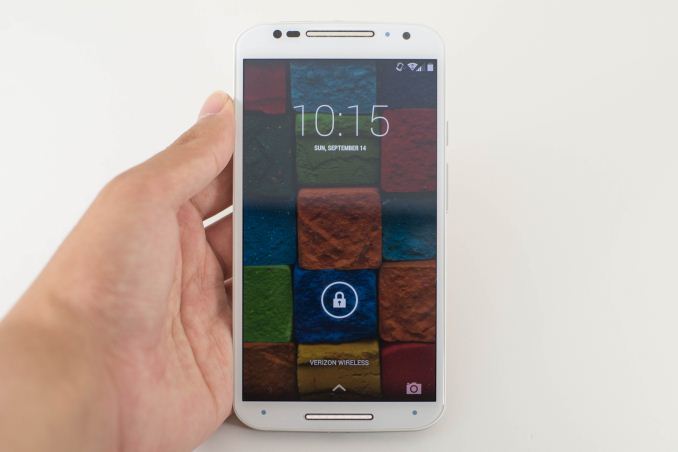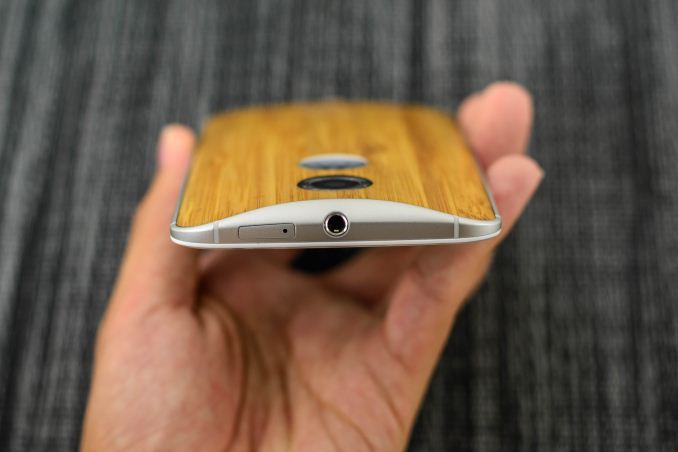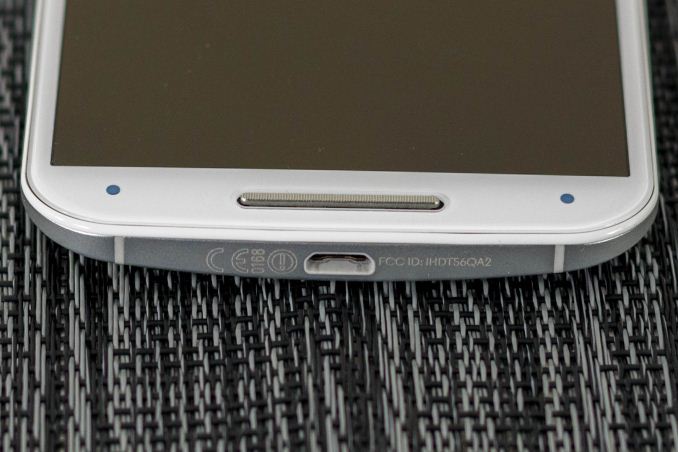The New Motorola Moto X (2nd Gen) Review
by Joshua Ho on September 17, 2014 9:00 AM EST- Posted in
- Smartphones
- Motorola
- Android
- Mobile

Introduction
While I talked about Motorola’s issues in the launch article for the new Moto X, it’s well worth repeating. Motorola has been through a lot these past few years. Once the iconic symbol of Android with their Droid smartphones, Motorola had lost its way. It wasn’t unusual to see one phone launch after the other, with no real regard for strategy, and no real cohesive message to tie all of their devices together. If anything, there was a point where Motorola had become an ODM for network operators in the US, with no real international presence. After Google acquired it in 2012, we saw the launch of the Moto X in 2013. The amount of hype that I saw online before the announcement of the Moto X was unlike anything I’ve ever seen.
Unfortunately, the device that launched didn’t quite fit with the hype. The Snapdragon S4 Pro chipset was decidedly mid-range by the time it launched. The display was good for the time, but AMOLED wasn’t quite the imminent LCD replacement that it is today. The camera was also rather unfortunate at launch. For better or worse, the Moto X was a phone with the right size and shape, but a lot of hardware choices that aged poorly. This leads us to the new Moto X. On the surface, this phone corrects a lot of issues that were present in the original Moto X. The new Moto X brings an SoC that is up to par with its competition, a new camera with a Sony sensor, and an improved AMOLED panel. Of course, I’m not going to spend too much time covering the basic specifications when a table will suffice.
| Motorola Moto X (Gen 1) | Motorola Moto X (Gen 2) | |
| SoC | 1.7 GHz Dual Core Snapdragon S4 Pro | 2.5 GHz Quad Core Snapdragon 801 |
| RAM/NAND | 2 GB, 16/32/64GB NAND | 2GB, 16/32GB NAND |
| Display | 4.7” 720p Super AMOLED | 5.2” 1080p Super AMOLED |
| Network | 2G / 3G / 4G LTE (Qualcomm MDM9x15 IP block UE Category 3 LTE) | 2G / 3G / 4G LTE (Qualcomm MDM9x25 IP block UE Category 4 LTE) |
| Dimensions | 129 x 65.3 x 5.7-10.4mm, 139 grams | 140.8 x 72.4 x 3.8-9.9 mm, 144 grams |
| Camera | 10MP Rear Facing, 1/2.6" CMOS size (OV10820), 2.1MP FFC | 13MP Rear Facing, 1/3.06" CMOS size (Sony IMX135), 2.1MP FFC |
| Battery | 2200 mAh, 3.8V, 8.36 Whr | 2300 mAh, 3.8V, 8.74 Whr |
| OS | Android 4.4.4 | Android 4.4.4 |
| Connectivity | 802.11a/b/g/n/ac + BT 4.0, USB2.0, GPS/GNSS, MHL, DLNA, NFC | 802.11a/b/g/n/ac + BT 4.1, USB2.0, GPS/GNSS, MHL, DLNA, NFC |
| SIM Size | NanoSIM | NanoSIM |
As with most reviews, physical impressions are always a good place to start. In terms of look and feel, the new Moto X starts off incredibly well. The metal frame is something that Motorola is especially proud of, as they've managed to enable an external antenna design without causing some of the infamous deathgrip issues. At any rate, it really feels great in the hand, especially because of the varying thickness. The metal frame can be as thin as 3.3mm in the corners, which really feels razor thin. Fortunately, the center is much thicker to provide for better grip. As a result, the phone is secure in the hand and I never really felt like I would drop it. Overall, I really think the feel of the phone is great. While the size is approaching an uncomfortable level, it manages to stay just short of it because the phone is so thin.
However, I’d like to cut this short as I’ve already given most of my initial impressions in the launch piece. While I haven’t been able to get around to writing my experience with Motorola’s tour, Motorola and their PR team have done an incredible job of introducing the product and allowing for plenty of time to get first impressions, photos, and ask all kinds of questions.
Cellular Architecture
Instead, given the amount of information disclosed by Motorola, I wanted to start this review with a discussion about cellular architecture, as it’s one of the few areas where we still seem to be working with black boxes. For those that are unfamiliar with the basics of how current RF architecture is set up, there are a few major components to talk about. We have antennas, antenna switches and duplexers, band filters, power amplifiers, a transceiver (which is made of multiple parts but that’s for another day), and the modem.
So let’s talk about what’s in the new Moto X. While antennas are still an area I’ve been working on learning more about, we can talk about band support on the Moto X. I’ve attached a table below with a full list of supported bands.
| Motorola Moto X (2014) | ||||||||
| FCC ID | Operator/Region Target | CDMA Bands | GSM | WCDMA | LTE | CA | ||
| IHDT56QA1 (XT1095/XT1097) | AT&T/T-Mobile USA | - | 850, 900, 1800, 1900 | 850, 900, AWS, 1900, 2100 | 2, 3, 4, 5, 7, 17, 29 | - | ||
| IHDT56QA2 (XT1096) | Verizon | 800, 1900 | 850, 900, 1800, 1900 | 850, 900, 1900, 2100 | 2, 3, 4, 7, 13 | - | ||
| IHDT56QA3 (XT1092) | ? | 800, 1900 | 850, 900, 1800, 1900 | 850, 900, AWS, 1900, 2100 | 2, 4, 5, 12, 17, 25, 26, 41 | - | ||
| IHDT56QA4 (XT1093/XT1094) | EU | - | 850, 800, 1800, 1900 | 850, 900, 1800, 1900, 2100 | 1, 3, 7, 8, 20 | - | ||
What might be notable is the lack of carrier aggregation on the new Moto X, which suggests that there is only a WTR1625L transceiver inside, with no WFR1620 companion chip to go with it. This is a rather conventional configuration at this point, and I suspect that phones with support for carrier aggregation will have to wait until WTR3925 which should be in most high end phones in 2015. The modem is also common at this point, as the MDM9x25 IP block in Snapdragon 800/801 has been around since the LG G2 which launched a year ago.
Of course, the real story here is the antenna tuner which I also wrote about in the launch piece. While most of the antenna tuner is hidden from view, there is one aspect that seems to be exposed to the OS. This one aspect is Cypress Semiconductor’s CapSense controller. This sounds strange, but I don’t think there’s any other explanation for why this controller is present. While it’s normally used for capacitive buttons such as in the Samsung Galaxy S/Galaxy Note line, there are no capacitive buttons or sliders present on the phone. In addition, none of the gestures/actions seem to rely upon capacitive sensing. This seems to rely upon the IR sensor system instead, so that doesn’t make sense either. The touchscreen is definitely an Atmel solution. This leaves the antenna tuner. While a bit outlandish, it seems that this controller is capable of detecting capacitance directly in addition to determining whether a finger/hand is on the sensor or not. While I’m sure that it’s necessary for Motorola to measure the standing wave ratio/signal reflection in addition to capacitive sensing on the relevant antenna pieces, this could give Motorola’s antenna tuner an advantage in speed as the capacitive sensors could detect the change in capacitance and pre-emptively change the tuning in the antennas instead of waiting for an increase in signal reflection before attempting to retune the antenna.













179 Comments
View All Comments
Alexvrb - Thursday, September 18, 2014 - link
Yeah the RAM and the CPU aren't that big of a deal to me, but if you're going to delete the mSD slot then your base model should be 32GB with a 64GB version as the upgrade.gg555 - Wednesday, September 24, 2014 - link
I agree. These days 16 Gb is a joke (which works out to more like 10 or 11 GB, once you account for the space the system takes up). These are multimedia devices. Once you start taking photos and video, downloading music and podcasts, doing some backups with Titanium or whatever, 16 GB really doesn't cut it. I struggle with this all the time on my Nexus 4.gg555 - Wednesday, September 24, 2014 - link
And they always want you to use the cloud as the solution to this problem. Seriously? Obviously they cannot possibly be ignorant about people having data caps on their plans. Not everyone can afford an unlimited plan. Or maybe this is just their way of colluding with the carriers to push people into more expensive plans. Anyway, the could is not a serious solution for a technology that has inherent network bandwidth issues.xaml - Saturday, September 27, 2014 - link
And security issues, which then reveal underlying issues with privacy, exhibitionism and respect. Not to mention the question of reliable access. And could it even be that data over radio is consuming more power than data over few or costly internal memory, respectively neglected external memory?erikiksaz - Tuesday, September 23, 2014 - link
Unlike Amazon, they're actually trying to make money off the hardware, hah. And I'm sure the cooling solutions for something of a tablet-sized form factor is much easier to tackle than on a smartphone.1080p on a 5.2 inch screen still results in a visible difference over 720p. 1440p, not so much.
bigstrudel - Thursday, September 18, 2014 - link
It's clearly the stock kernel which reduces battery runtimes on ALL nexus devices.julianocas - Thursday, September 18, 2014 - link
peGGi - Friday, September 19, 2014 - link
Kudos to Motorola for the impressive engineering that went into the metal-band-as-antenna. I like that about Motorola, that they put time and effort into things that users may not immediately notice, but should definitely improve the everyday quality of the experience of using a phone for its primary use - to make calls. But........ the metal band ruins the design, compared to X Gen 1, sadly. Screen-plate aside, the casing now seems to consist of 3 parts rather than 2. I loved the slopey, curviness of the first gen, and the way that the backplate curved round the sides, and met the front plate in the middle. That unity of design is gone now, and this second gen looks a bit awkward imo. The front and back of the phones don't match that well anymore. There was a lovely overall unity in aesthetic to the first Gen, which has been broken on the 2nd.
I also agree with the commenters that it is too big. Just like the S5, G3, and One M8 are all too big. For my very average sized male hands, the Gen One's ergonomics were perfect.
Sensors at the top on the front, especially on white model, look messy. Could they not all have been put behind one, long translucent black strip, along with the speaker grille, or something like that? Or tidied up a bit better?
I think Motorola would've been better sticking to the compact, ergonomically wonderful design of Gen 1, but with improvements to the internals (camera, SoC, colour accuracy, battery life). They'd have a great performing phone that fits better in the hand than all their rivals, for a lower cost than their rivals.
And then it would make sense to have a 5.5inch-ish size 'phablet' too, big screen, big tricks, etc. They'd be competing just above and just below the S5 and I'd say they'd rip chunks out of the market that way.
It looks like the Gen 1 is gonna go down as a classic, flawed and all as it was.
Harry_Wild - Friday, September 19, 2014 - link
I agree with your remark on the Moto X 2014! It much bigger then the Moto X which is great feeling and the right size for me small hands. But I am surprise Motorola went to a much larger size too! Motorola should of made the Moto X 2014 the same size; and they have the Moto G - 5" for anyone wanting a larger model. That would have been perfect decision. I going to the Apple store and looking at the 4.7" iPhone 6!dsouza - Friday, September 19, 2014 - link
@Harry_Wild, the new iPhone 6 (5.44 x 2.64in) is just marginally smaller than the Moto X 2014 (5.54 x 2.85)! So, if you believe that the new Moto X is too big for you, probably the new iPhone 6 will be so!